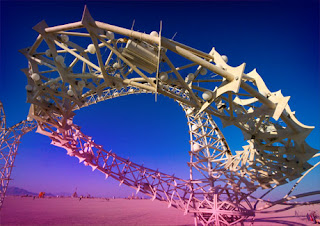Week Nine: Space + Art
This week's topic focus on how art and space intertwine.
Personally, I've always found space very beautiful. Copernicus' heliocentric
model was one of the first to both mathematically and artistically display the
sun in the middle of our enormous solar system (Vesna). As the telescope and more
powerful magnification tools emerged in the scientific community, so did
photography of the planets, stars, and even far reaching galaxies. Pictured below, top, is an example of the Hubble telescope's far reaching abilities to pick up images of a nebula (Hubble Heritage Team). In comparison to William Parson's drawing of a nebula (M51) (most bottom), the actual picture of a nebula is far more beautiful, intricate, and awe-inducing than our human imaginations (Andersen). However, there is no denial that any space exploration led to art; Parson's drawing is theorized to have inspired Van Gogh's 'Starry Night' (Andersen).
However, space, much like nanotechnology, has so many
unknowns that it was only natural for art to emerge from it. Artists used their
imaginations every day to create media that may portray living on these foreign
planets, as we simply didn't know what existed there. Science-fiction artists
were the first to provide many scientific ideas, like the space station that
later became reality through Russian space programs and NASA. (Vesna) Trips
into space were pioneered by dogs and monkeys, and these brave travelers (all
of which died) were immortalized via artistic renditions, such as
those on stamps. People, too, many of whom passed away, led to artistic
responses such as the Columbia space shuttle memorial, a beautifully carved
gravestone, or songs and poems written about those who lost their lives
(Hansen, Smith). For example, teenager Jessi Hall wrote a poem including the
lines, "Oh starry skies will keep them safe/but what of us down here/tears
are shed for those who stay/in orbit 'round reality" (Hansen).
In a similar way, this transition to space travel as a
commonality led to media portrayals of human life on the moon and other
planets. Shows like Lost in Space, which featured the Robinsons stranded on a
foreign planet, were hits among TV-watchers (Lost in Space). My mom has even
spoken about how popular the Robinsons, The Jetsons, and all of Star Trek were
when she grew up. The shows allowed for creative expansions. We don't actually
have jet packs that easily propel you through space, especially not without a
space suit, yet Lost in Space featured such inventions (Lost in Space). What
was possible and what was not was not irrelevant, it was unknown.
Sources:
Andersen, Kurt. "Was Van Gogh's 'Starry Night' inspired by a scientific drawing?" PRI. PRI, 29 Jan 2015. Web. 29 May 2017.
Hansen, Liane. "Poem on
the Space Shuttle Columbia Crash." NPR. NPR, 2 Feb 2003.
Web. 29 May 2017.
"Lost in Space." IMDb.com. Amazon,
2017. Web. 29 May 2017.
Smith, Sonia.
"Remembering the Space Shuttle Columbia." Texas Monthly. Texas
Monthly, 30 Jan 2013. Web. 29 May 2017.
Vesna, Victoria. Space Pts.
1-6
https://cole2.uconline.edu/courses/684222/pages/unit-9-view?module_item_id=11226181
Pictures:
Parson William. Digital Image. "Whirlpool Galaxy." PRI, 29 Jan 2015, https://www.pri.org/stories/2015-01-29/was-van-goghs-starry-night-inspired-scientific-drawing.
NASA. Digital Image.
"Pillars of Creation." Wikipedia, Hubble Heritage
Team, 29 Oct 2014, https://en.wikipedia.org/wiki/Hubble_Space_Telescope.
Smith, Sonia. Digital
Image. "Remebering the Space Shuttle Coloumbia." Texas
Monthly, Ron Edmonds, 30 Jan 2013,
http://www.texasmonthly.com/the-culture/remembering-the-space-shuttle-columbia/.
Vejvoda, Jim. Digital
Image. "The Jetsons Animated Movie in the Works." IGN, 25
Jan
2015, http://www.ign.com/articles/2015/01/25/the-jetsons-animated-movie-in-the-works.






Comments
Post a Comment